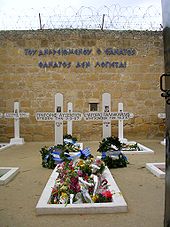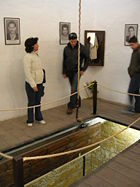
Imprisoned Graves
Encyclopedia

Central Jail of Nicosia
The Central Jail of Nicosia is the only correctional facility in Cyprus. It is located to the west of the walled part of the Cypriot city of Nicosia, south of the Green Line...
, where 13 EOKA
EOKA
EOKA was an anticolonial, antiimperialist nationalist organisation with the ultimate goal of "The liberation of Cyprus from the British yoke". Although not stated in its initial declaration of existence which was printed and distributed on the 1st of April 1955, EOKA also had a target of achieving...
fighters, during the 1955-1959 liberation struggle for the liberation of Cyprus from the United Kingdom, were interred. Nine of them were hanged by the British, three were killed in action and one died in hospital from his battle wounds.
The tombs were built in an area adjacent to the cells of the condemned and close to the gallows where they would be executed. The area is surrounded by tall walls and covered by glass.
The small cemetery was a brain-child of Cyprus
Cyprus
Cyprus , officially the Republic of Cyprus , is a Eurasian island country, member of the European Union, in the Eastern Mediterranean, east of Greece, south of Turkey, west of Syria and north of Egypt. It is the third largest island in the Mediterranean Sea.The earliest known human activity on the...
Governor Sir John Harding who did not want the funerals of EOKA fighters to be turned into demonstrations against British rule. The condemned, as well as the four others who died, would be buried in the area without any relatives or a priest present. The nine men that were hanged were buried immediately following their execution. To save space, they were buried two to a grave.
The nine men who were executed were:
- Michalis KaraolisMichalis KaraolisMichalis Karaolis was born in the village of Palechori of Pitsilia, Cyprus. He was a government clerk and a member of EOKA. He was the first to be sentenced to death and hanged alongside Andreas Dimitriou on May 10, 1956....
- Andreas Dimitriou
- Iakovos Patatsos
- Andreas Zakos
- Harilaos Michael
- Michail Koutsoftas
- Stelios Mavrommatis
- Andreas Panagidis
- Evagoras Pallikaridis

- Markos DrakosMarkos DrakosMarkos Drakos was a Cypriot guerrilla fighter who was killed in the EOKA struggle against the British. His nom de guerre was Lykourgos....
- Grigoris AfxentiouGrigoris AfxentiouGrigoris Pieris Afxentiou was a guerrilla fighter who fought against the British rule of Cyprus and is considered a national hero. In the hierarchy of EOKA he was second in command to general Georgios Grivas...
- Stylianos LenasStylianos LenasStylianos Lenas was born in Handria, Cyprus and was a member of EOKA.- Early life :Stylianos Lenas was born into a poor family in Handria. When he finished the local school in his village, he took a job in town. He went to Lero for further studies and when he returned, he opened a shop.- EOKA :He...
- Kyriakos MatsisKyriakos MatsisKyriakos Matsis was a Greek Cypriot guerrilla member of EOKA. He was Yiannakis Matsis' brother who is Member of the European Parliament for Cyprus- Early life :Matsis was born in Palaichori, Cyprus...
After Cyprus gained her independence, the area became a national monument where thousands visit. A sign proclaiming "Του ανδρειωμένου ο θάνατος, θάνατος δεν λογιέται" - "The brave man's death is no death at all" was put up against one of the walls.
During the Turkish invasion of Cyprus
Turkish invasion of Cyprus
The Turkish invasion of Cyprus, launched on 20 July 1974, was a Turkish military invasion in response to a Greek military junta backed coup in Cyprus...
(1974) battles raged around the Central Jail of Lefkosia. Vastly outnumbered, the Cypriot national guardsmen - aided by corrections officers - managed to fight off the Turks and keep the jail with its Imprisoned Tombs from being captured.
Today, the cemetery along with the cells and the gallows function as a museum.

